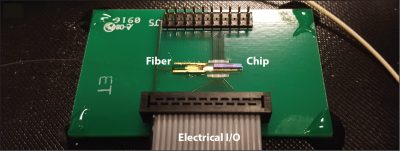
In the recently published Optics Letters manuscript, the first demonstration of chip-scale coherent light detection and ranging (LIDAR) based on silicon photonic optical phased arrays with solid-state beam steering has been shown. Throughout the past decade, LIDAR has garnered significant interest as a ranging technology because of its potential to achieve long range and high resolution due to the small wavelength of light. LIDAR has seen extensive use in autonomous vehicles, robotics, aerial mapping, and atmospheric measurements. In steered applications, many LIDAR systems available today utilize a mechanical mechanism such as a gimbal. However, such mechanisms limit scan rate, decrease reliability, and increase system size and cost. The form-factor and cost of LIDAR systems are impeding the possibility of being commoditized in autonomous drones, car, and vehicles. With the advent of integrated optic fabrication in foundries, there has been an emphasis towards solid-state beam steering systems to reduce form-factor and cost.
In this work, chip-scale integrated optical phased arrays are used to steer the light non-mechanically. These phased arrays have a high steering range and are used as a transmitter and a receiver to scan the environment in two dimensions. The received light passes directly into an integrated germanium photodetector for coherent optical detection. A coherent LIDAR detection technique was chosen over traditional time-of-flight because coherent amplification eliminates the need for complex and expensive avalanche photodetectors. Additionally, low-cost telecom laser sources used in this LIDAR system are readily available. Furthermore, this technique allows for simultaneous distance and velocity measurements of objects and rejects ambient light such as sunlight or other LIDAR modules.
For LIDAR to become a ubiquitous ranging technology, low cost and readily available systems are crucial. The devices in this work are fabricated in a CMOS foundry on 300mm silicon-on-insulator wafers and can be mass produced at a high volume in the same fashion as microelectronics. This work paves the way for small form-factor, highly reliable and low cost on-chip LIDAR modules combined with CMOS electronics and lasers. This disruptive technology has applications in the fields of robotics, proximity sensors, cell phones, medicine, and the ultimate market of autonomous vehicles. Currently, commercialization of this technology is taking place at Analog Photonics
For more information on this work, please contact: cpoulton@analogphotonics.com
